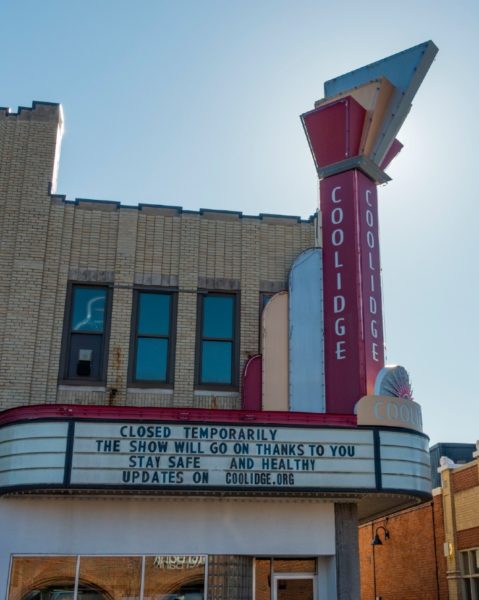In 2016, the Coolidge Corner Theatre in Brookline, Massachusetts hosted a screening of Contagion—the prescient Steven Soderbergh thriller about a global pandemic—as part of its long-running Science on Screen series. To highlight the science behind the film, the theater invited Dr. George Church, a professor of genetics at Harvard Medical School, to give a pre-film presentation.
“[The movie] was freakishly realistic, and it was a very scary presentation,” Coolidge Corner director of development and marketing Beth Gilligan tells Boxoffice Pro. “And then that became like a documentary for us all.”
Launched in 2010, Science on Screen is a partnership between Coolidge Corner (a nonprofit theater) and the Alfred P. Sloan Foundation, which offers an annual grant to the Coolidge to produce the series. A “large portion” of that money is then re-granted to other cinemas across the U.S. to facilitate their participation. Since its inception, 96 theaters in total have held Science on Screen events, while around 35 cinemas are on the current grantee roster.
The series’ emphasis on unpacking the science behind films both old and new has become even more relevant in the current era, when purveyors of anti-science misinformation have utilized the amplifying power of social media to devastating effect. While vaccine hesitancy—the most pressing anti-science issue of the moment—has yet to be spotlighted, Gilligan says messages grounded in scientific realities are much-needed amid the dangerous untruths and conspiracy theories that have spread far and wide since the pandemic’s beginnings.
“This is a year where the importance of science and scientific literacy and scientific facts have really come to the forefront,” Gilligan notes. “So we are happy to do whatever small part.”
The Coolidge and its current crop of grantees—comprised of theaters from Santa Ana, California to Bethel, Maine—recently wrapped National Science on Screen, an annual “unifying” event where participating theaters host a Science on Screen experience on the same day. Held on March 24 this year, participating cinemas hosted virtual and drive-in screenings and panels around films including the 2017 blockbuster Hidden Figures (featuring STEM-equity experts Samantha Elliott-Briggs and Calvin Briggs), 1978’s Invasion of the Body Snatchers (featuring psychology professor Ines Segert), and David Lynch’s Eraserhead (featuring psychology and brain science expert Amir Raz).
The Eraserhead screening was hosted by The Frida Cinema in Santa Ana, the only nonprofit art house in Orange County, California. The theater’s founder and executive director, Logan Crow, became aware of Science on Screen during a pilgrimage to the annual Art House Convergence in Utah, where the Coolidge holds a special presentation about the series every year (last year’s event was canceled due to the pandemic).
Crow describes the Frida’s drive-in Eraserhead screening and post-film discussion with Raz, a professor at nearby Chapman University, as a success. “We were all so glad to only see maybe two or three cars leave at the end of the film,” Crow tells Boxoffice Pro. The remainder stuck around for a lecture and Q&A entitled “The Nocturnal Odyssey of the Cognitive Brain,” in which Raz explored the deeply subjective nature of Lynch’s works and even discussed promising studies on so-called “micro-dosing” as an alternative mental health treatment. To participate, audience members were invited to send questions in advance via the Frida’s official website.
At the Coolidge, UCLA economics professor Michael Suk-Young Chwe—author of the book Jane Austen: Game Theorist—participated in a virtual Q&A for National Science on Screen around writer-director Amy Heckerling’s 1995 classic Clueless. During the panel, Chwe discussed the deeper connections between Austen’s writing and the high-school comedy, which Heckerling loosely based on the author’s 1815 novel, Emma.
The virtual format—which the Coolidge has also employed for its other ongoing screening events, including the popular Coolidge Education series—has forced the theater to rejigger the way it approaches Science on Screen. For in-person events prior to the pandemic, each film in the series would be introduced by a 20-minute lecture from a prominent scientific expert. But with activities outside the home greatly curtailed over the past year, Gilligan and her team decided to expand those discussions to a longer Q&A format, with each attendee invited to watch the film beforehand on their own time. The lectures themselves are free to attend and readily available to watch on YouTube for those who aren’t able to tune in live.
The types of films being screened have also changed. The difficulty of attaining streaming rights to older, more mainstream titles—the original mandate of the series was to make science accessible through pop entertainment—meant the theater was forced to lean heavily on independent content featured in its virtual screening room, including first-run films such as Coded Bias and Radium Girls, which attendees were invited to watch, for a fee, prior to the discussions. They decided to deviate from that formula with Clueless, a rare exception given its longstanding popularity. “Many people are pretty familiar with it, so it was okay if we weren’t showing Clueless,” says Gilligan. “[The audience] would grasp it easily enough.”
The Coolidge’s final Science on Screen event of the season (the theater puts the series on hiatus during the summer) is the documentary In Silico, which follows an ambitious scientist attempting to map the human brain. When the series returns in the fall, Gilligan suspects they’ll be introducing a hybrid format—both in-person and virtual—but that all depends, of course, on where the pandemic stands come September. Gilligan, for one, isn’t counting out any eventuality.
“Hopefully in the fall, we’ll be able to return in person,” she says. “But who knows.”
You can find an archive of past Science on Screen presentations here.



Share this post